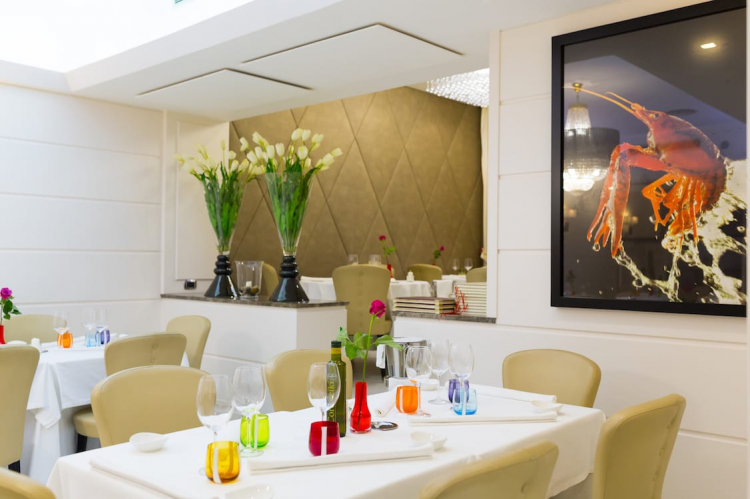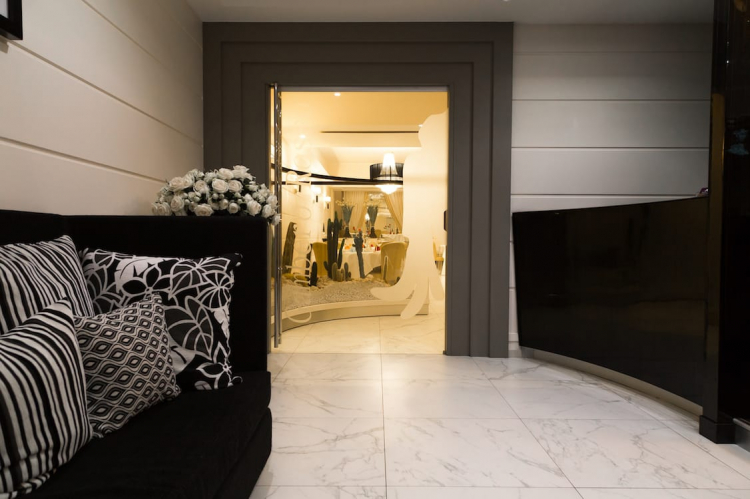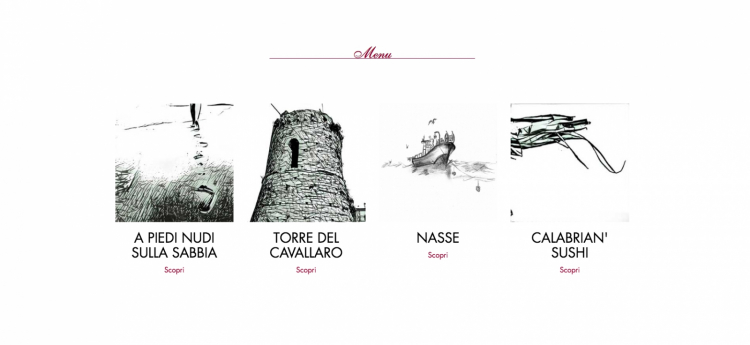There’s no sign of the Michelin star, conquered in 2013 and never lost since, at the entrance of the restaurant: «We decided not to show it. It made people uneasy. Scared them, “who knows what I’ll end up eating, how much I’ll spend, how it works”. They were scared to come in». So the most prestigious award is in the drawer. But the restaurant is crowded. This is how it works in Marina di Gioiosa Ionica, an extreme place, the southern frontier of fine dining. Almost an outpost, like Fort Alamo in a land of great products and difficult social issues, of excellent trattorie offering large quantities, and few bourgeois restaurants surviving mostly by catering events: weddings, christenings and confirmations offer the chance for crowded parties, without paying too much attention to the budget. Then there’s the tourist season. Otherwise, you need to be really good.
Indeed the Scullis are really good, and determined. They’re not part of the offspring of the historic masters, Gaetano Alia, Giovanni Bazzarelli, the pioneers of Calabria, so to speak (where before 2012 only three restaurants were starred, L'Aragosta in Marina di Nocera Terinese, La Locanda di Alia in Castrovillari and Lapprodo in Marina di Vibo Valentia, which has just conquered back its star). And they don’t belong to the regional nouvelle vague, formed by the young and much talked-about chefs from Cooking Soon – Abbruzzino, Ceraudo, Rossi, Biafora, Di Pace, Lecce, Strigaro.
It’s a matter of generations: chef
Riccardo Sculli was born in 1975, a middle age that means he’s not part of the emerging talents in local cuisine, but still deserved our visit to
Gambero Rosso, rewarded with a series of delicacies giving honour to the exceptional raw materials of the surroundings.
Sculli sums it up like this: «Being an entrepreneur is not enough here. You need to love this place» tormented but lucky. «After all, it’s a lucky place, we have two fantastic seas» only 50 km apart, though you have to drive on wretched roads, with his majesty Aspromonte in between. It’s like an endless treasure chest of biodiversity, «when the Ionian Sea is rough, and it’s impossible to fish, the Tyrrhenian Sea is almost always calm and full of fish, and vice versa», so you always have your supply.


There are many delicacies. The chef says: «First of all I’d say crustaceans, and seabed fish, they’re exceptional: the Ionian Sea is the deepest in Italy, and offers fabulous gifts. Then there’s cheese, starting from caciocavallo di Ciminà. And tomatoes: they now cultivate some extraordinary yellow date tomatoes. And fruits of the forests: some famous brands get their supplies here. I have to fight to keep some boxes before they’re sent elsewhere. There’s saffron from Gerace and melanzana perlina [a variety of aubergines], and lemons and oranges on Aspromonte that stay juicy until August». And there’s ‘nduja, «many only know its industrial, mediocre version, in which the spiciness prevails. Yet the one properly made is balanced and tasty».
Gambero Rosso is a direct emanation of this ark of flavour. The story of this place, created with the efforts and passion of two generations, is beautiful: the restaurant was born when dad Giuseppe Sculli and mum Anna Maria returned home, with the desire to create their future where they started from, before going in search of luck abroad, especially in Canada. In Toronto, where Riccardo was born.

Gambero Rosso, on top of the à la carte menu, has numerous tasting menus too: a mano libera, a menu with their classics, plus special menus called Calabrian' sushi (with raw fish), A piedi nudi sulla sabbia, Torre del Cavallaro (it’s a fortress from the 15th century in Marina di Gioiosa Ionica but some experts think it was in fact founded in the Byzantine days, the work of a Greek strategist who wanted to limit the impetus of the Saracen hordes. Two guards on horsebacks, called cavallari, had to signal any approaching Barbarian brigade) and Nasse (a typical fishing technique from Southern Italy: in order to catch precious fish (white beam and snapper) they let the nets fall on the rocky seabeds or mixed with posidonia, with a bathymetry never exceeding 40 metres. When fishing pink prawns, langoustines and red king prawns, the nets are used on much deeper seabeds, often reaching a bathymetry of 200-300 metres)
In 1979 the bet taken by the couple, just back to the village, turned into restaurant
Gambero Rosso where they wanted to enhance the good things their homeland offered. Today the story continues with three of their children:
Riccardo, and
Francesco running the dining room and
Tiziana helping him out. The chef says: «My parents first opened a small store selling panini and other simple food. My mother started to work in the kitchen and the place grew bit by bit. We lived on top of the restaurant [the location never changed] so it was natural that after school I’d help in the kitchen». There’s never been a moment of discontinuity, a planned decision to try to take a leap in quality; instead, the growth was always careful, never taking steps too big, with the mind always alert.
An anecdote: «A fisherman, Bartolo, used to throw the scampi caught into his net back into the sea. My dad asked him why. He said nobody would buy them, so what use could he have of them? They weren’t considered precious. So we asked him to give them to us instead: he gave them from free, to him they had no value. He gradually realised they had become a delicacy for our clients so one day he called on his trumpet as usual, and when in front of the restaurant with his catch, he screamed: “Peppe, you want the scampi? E mò mì paghi”, you’ll have to pay them now».
The Sculli family never abandoned the basic idea they had right from the start: offering excellent Mediterranean cuisine. These days they do it as fine dining, as you’ll see in the photo gallery, with photos by Tanio Liotta.
Translated into English by Slawka G. Scarso